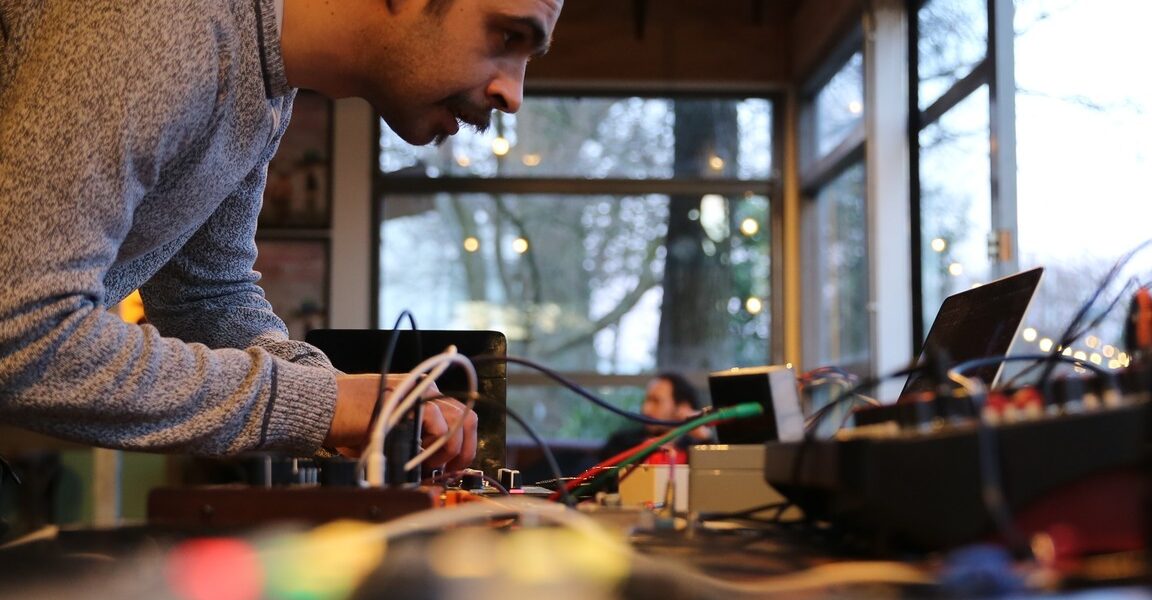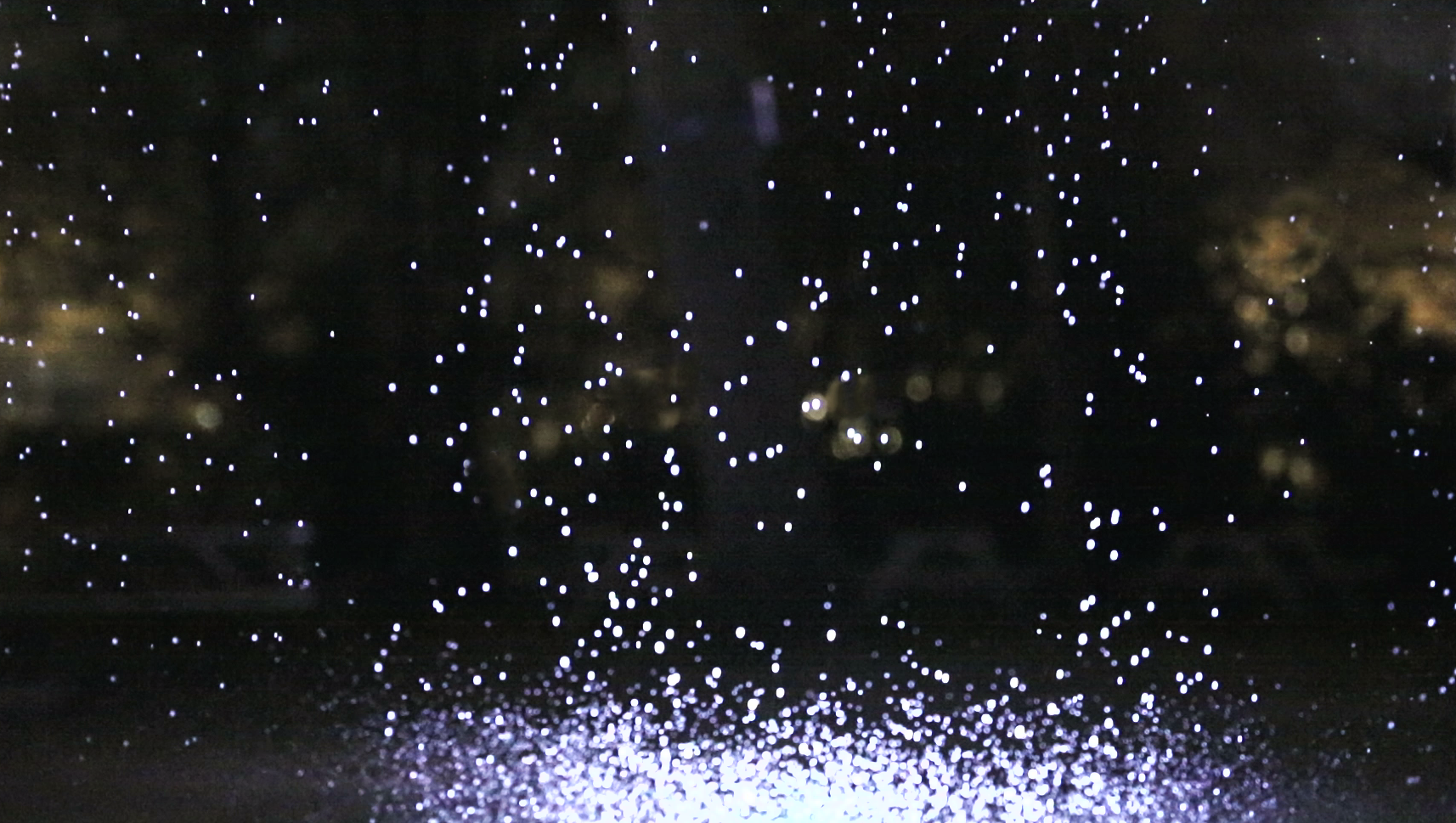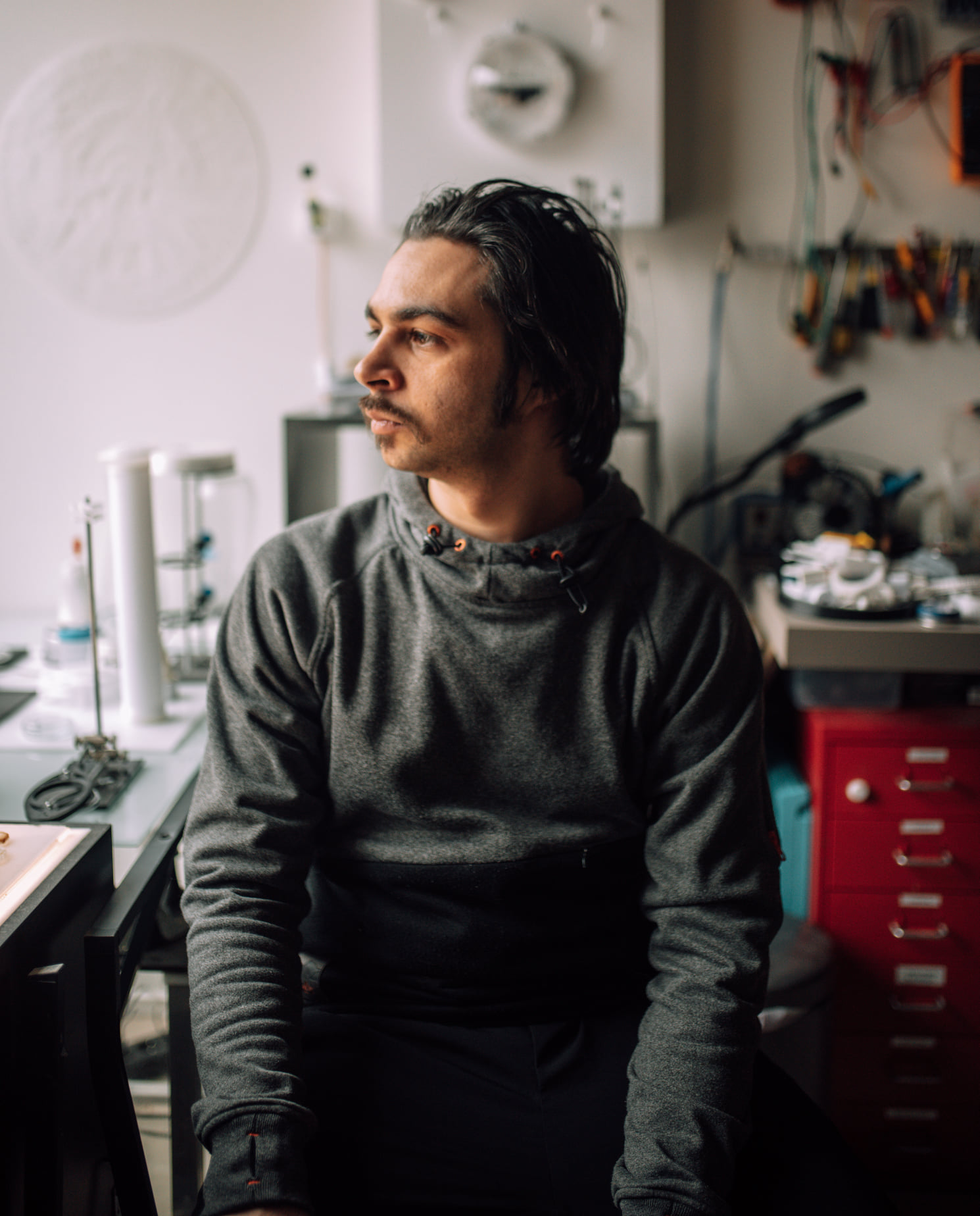Federico Murgia: Spectrum Tempesta
di Diego Repetto
«Nobile claret opus, sed opus quod nobile claret
Clarificet mentes, ut eant per lumina vera
Ad verum lumen, ubi Christus janua vera
Quale sit intus in his determinat aurea porta:
Mens hebes ad verum per materialia surgit,
Et demersa prius hac visa luce resurgit».
De administratione, 46, 27-48, 4
Sul portale centrale del lato occidentale della Cattedrale di Saint-Denis si legge:
«La nobile opera risplende, ma l’opera che nobilmente risplende dovrebbe illuminare gli spiriti, di modo che, attraverso luci vere, essi giungano alla Luce vera, per la quale Cristo è la vera porta [d’accesso]. In che modo sia presente [la vera Luce] in queste [luci] lo mostra la porta aurea: anche lo spirito ottuso si eleva, attraverso la realtà materiale, al Vero; esso, che prima era sprofondato, ora, alla vista di questa luce, risorge».
Questa citazione e tante altre apposte dell’Abate Suger sui portali e sulle vetrate della cattedrale gotica francese suggeriscono che la realtà materiale acquisisce attraverso l’uso della luce una funzione anagogica. Questa funzione conduce il pensiero al di là di se stesso, pensiero che trova la sua massima espressione nella metafisicità della luce.
La luce è architettura, sublimazione e spiritualizzazione del materiale.
Con ciò non si vuole scrivere un trattato filosofico e teologico sull’architettura gotica, ma si intende utilizzare l’esempio dell’uso sapiente della luce nella grande cattedrale di Saint-Denis, espediente nella ricerca del divino, come premessa al lavoro stupefacente dell’artista multidisciplinare Federico Murgia, che plasma la luce e gli elementi naturali per amplificare nel pubblico la consapevolezza dell’intima connessione uomo-ambiente.
Un esempio di sublimazione della materia in luce è Spectrum Tempesta, opera nata dalla collaborazione tra l’artista multidisciplinare e il produttore/ingegnere del suono Lorenzo De Beris. Spectrum Tempesta è un sistema sinestetico per performance immersive site-specific che mira a condurre il pubblico in uno stato aumentato di consapevolezza in relazione al mondo naturale e a fenomeni atmosferici. Una cerimonia artistica che celebra l’unicità degli eventi climatici e degli stati dell’acqua, distorcendoli e rimodellandoli attraverso motivi di luce e suono accuratamente generati. Una profonda simbiosi tra natura e tecnologia che mira a trascendere questa dualità attraverso un’esperienza orchestrata che riunisce la spontanea casualità e le pure qualità cinetiche degli eventi naturali con strutture tecnologiche e modelli astratti. Una sorta di manifesto performativo della tecno-ecologia.
Tecnicamente Spectrum Tempesta consiste nell’uso di luci stroboscopiche colorate e di elaborazioni sonore vive per esaltare fenomeni atmosferici a base d’acqua, come una grandinata, un temporale, una nebbia densa.
Questo progetto mira a fornire una full immersion negli elementi naturali alterando la percezione sensoriale e la risposta cognitiva verso fenomeni atmosferici che ci sono familiari ma a cui solitamente non prestiamo attenzione.
Utilizzando modelli forniti dai fenomeni metereologici, e artificialmente attraverso un sistema di irrigazione a pioggia, Murgia e De Beris trasformano e sezionano in tempo reale, sia visivamente che acusticamente, l’atmosfera circostante. La manipolazione dal vivo trasforma la percezione dell’ambiente circostante in una tempesta digitale guidata dai dati.
Si sono progettati software e dispositivi che forgiano un’esperienza visiva e sonora dall’interazione con gli eventi climatici.
L’attrezzatura coinvolta nel sistema è composta da vari tipi di tecnologie: una serie di luci stroboscopiche e microfoni a contatto costruiti su misura, microcontrollori Arduino ed ESP, sensori, una rete wireless personalizzata che utilizza protocolli OSC e WDMX, strobo DMX e sintetizzatori analogici, software come Max/MSP e Ableton Live,
La performance utilizza l’elaborazione del suono sia analogica sia digitale per esplorare diversi modi di sottolineare certi modelli acustici coerenti con vari fenomeni atmosferici. Inoltre è stato progettato un sistema modulare di dispositivi impermeabili personalizzati contenenti luci stroboscopiche RGB e microfoni a contatto da distribuire nello spazio che serve come output visivo e input sonoro per la performance.
Attraverso questa catena personalizzata di luci e sistemi audio, si stabilisce una connessione diretta tra i modelli riconosciuti nei fenomeni naturali, le sequenze visive e musicali. Questa comunicazione tra suono, luci ed eventi organici, è in grado di alterare la percezione della realtà (ambiente sensoriale) e guidare sinesteticamente il pubblico verso stati mentali sconosciuti e sorprendenti.
Quindi, se in Suger ritroviamo il concetto di «lux mirabilis et continua» (De consecratione, 100, 20) rivolto a un aspetto prettamente di fede (in cui si fa leva sull’immaginario del fedele), in Murgia il metafisico diventa realtà. L’artista, come un’alchimista, crea attraverso l’uso della luce e dell’acqua architetture effimere e ambienti immersivi che amplificano l’esperienza percettiva del pubblico.
in breve
Federico Murgia – bio
Federico Murgia è un artista multidisciplinare italiano che vive e lavora ad Haarlem/Amsterdam. Ha conseguito una laurea in arti grafiche all’Accademia delle Belle Arti di Bologna e un MFA in Interactive Media and Environments al Frank Mohr Institute di Groningen. Il background di Murgia nella grafica e nel disegno si è espanso verso pratiche più immersive e ibride, esplorando le correlazioni intangibili tra suono, luce e altri elementi ai margini dell’involucro percettivo umano. Sia nelle sue produzioni scultoree e grafiche, sia nelle sue installazioni site-specific, Murgia è particolarmente interessato a evocare sensazioni insolite e ancestrali, innescando esperienze sensoriali al limite della trascendenza. Lavora presso Optofonica con Maurizio Martinucci (TeZ), un laboratorio di Arte/Scienza ad Amsterdam. Ha collaborato con designer, musicisti e molti altri creativi di diverse discipline. I suoi lavori sono stati esposti in tutta Europa in musei (come EYE Film Museum NL, Palazzo Gambalunga IT); festival (come Dutch Design Week NL, Gogbot NL, Share IT); gallerie (come Galerie Reuten NL, Np3 NL, L’Ariete IT); luoghi indipendenti (come The Gym NL, The New Current NL, The Drawing Hub DE) e fiere d’arte (Art on Paper NL, The Others IT).
Arch. Diego Repetto

www.diegorepetto.it
FB – LK – IG – YT
English version

Federico Murgia: Spectrum Tempesta
by Diego Repetto
On the central portal of the western side of Saint-Denis’s cathedral we read:
“The noble work shines, but the work that nobly shines should illuminate the spirits, so that, through true lights, they come to the true Light, to which Christ is the true door [access]. How [the true Light] is present in these [lights] is shown by the golden gate: even the dull spirit rises, through material reality, to the True; it, which before had sunk, now, at the sight of this Light, rises again”.
This quote and many others affixed by Abbot Suger to the portals and stained glass windows of the French Gothic cathedral suggest that material reality acquires an anagogic function through the use of light. This function leads thought beyond itself, a thought that finds its maximum expression in the metaphysical aspect of light.
Light is architecture, sublimation and spiritualization of the material.
We do not want to write a philosophical and theological treatise on Gothic architecture, but we intend to use the example of the skillful use of light in the great cathedral of Saint-Denis, an expedient in the search for the divine, as a premise to the amazing work of the multidisciplinary artist Federico Murgia, who shapes light and natural elements to amplify the public’s awareness of the intimate connection between man and environment.
An example of the sublimation of matter into light is Spectrum Tempesta, a work born from the collaboration between the multidisciplinary artist Federico Murgia and the producer / sound engineer Lorenzo De Beris.
Spectrum Tempesta is a synesthetic system for site-specific immersive performance that aims to drift the audience into an augmented state of awareness in relation to the natural world and more or less familiar natural phenomena. An artistic ceremony that celebrates the uniqueness of climate events and water states, distorting and reshaping them through carefully generated light and sound motifs. A profound symbiosis between nature and technology that aims to transcend this duality through an orchestrated experience that brings together the spontaneous randomness and the pure kinetic qualities of natural events with technological structures and abstract patterns. A sort of techno-ecology performative manifesto.
Technically Spectrum Tempesta consists of the use of colorful stroboscopic lights and live sound processing to enhance water-based atmospheric phenomena, such as hailstorms, rainstorms, dense fog and so on.
This project aims to provide a full immersion in the natural elements altering the sensorial perception and cognitive response toward atmospheric phenomena that are familiar but we don’t usually pay attention to.
Utilizing patterns provided by the weather, and artificially through a sprinklers irrigation system, the artists transform and dissect in real-time, both visually and acoustically, the surrounding atmosphere. The live manipulation transforms the perception of the surrounding into a data-driven digital storm.
The artists designed software and devices that forge a sound and visual experience from the interaction with the climatic events.
The equipment involved in the system is composed of various kinds of technologies: a series of custom-built strobe lights and contact microphones, Arduino and ESP microcontrollers, sensors, a custom wireless network using OSC and WDMX protocols, software as Max/MSP and Ableton Live, DMX strobes and analog synthesizers.
The performance uses both analog and digital sound processing to explore different ways to underline certain acoustic patterns coherent with various atmospheric phenomena.
The artists designed a modular system of custom waterproof devices containing RGB strobe lights and contact microphones to be distributed in the space that serves as visual output and sound input for the performance.
Via this custom chain of light and audio systems, they establish a direct connection between recognized patterns in the natural phenomena and visual/musical sequences. This back and forth communication among sound, lights and organic events, its able to alter the perception of reality (sensorial ambiance) and synesthetically guide the audience to uncanny states of mind.
Thus, if in Suger we find the concept of “lux mirabilis et continua” (De consecratione, 100, 20) aimed at a purely faith-based aspect (in which the believer’s imagination is appealed to), in Murgia the metaphysical becomes reality. The artist, like an alchemist, creates ephemeral architecture and immersive environments through the use of light and water that amplify the perceptive experience of the public.
in short version
Federico Murgia – bio
Federico Murgia is an Italian multidisciplinary artist who lives and works in Haarlem/Amsterdam. He received a BA of Graphic Arts at Accademia delle Belle Arti in Bologna, and a MFA in Interactive Media and Environments at the Frank Mohr Institute in Groningen. Murgia’s background in graphics and drawing has expanded towards more immersive and hybrid practices, exploring the intangible correlations between sonic, light and other elements at the edge of the human perceptual envelope. Both in his sculptural and graphical productions, as well as in his site-specific installations, Murgia is particularly interested in evoking unusual and ancestral sensations, triggering sensorial experiences at the verge of transcendence. He works at Optofonica with Maurizio Martinucci (TeZ), a laboratory for Art/Science in Amsterdam. He collaborated with designers, musicians and many other creatives from different disciplines. His works have been exhibited across Europe in museums (as EYE Film Museum NL, Palazzo Gambalunga IT); festivals (as Dutch Design Week NL, Gogbot NL, Share IT); galleries (as Galerie Reuten NL, Np3 NL, L’ Ariete IT); independent venues (as The Gym NL, The New Current NL, The Drawing Hub DE) and art fairs (Art on Paper NL, The Others IT).









